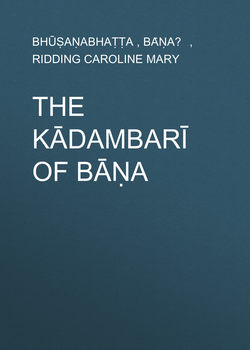Читать книгу The Kādambarī of Bāṇa - Bhūṣaṇabhaṭṭa - Страница 6
INTRODUCTION.1
References to Kādambarī in the Sāhitya-Darpaṇa and elsewhere
ОглавлениеThe author of the Sāhitya-Darpaṇa7 speaks of the Kathā as follows: ‘In the Kathā (tale), which is one of the species of poetical composition in prose, a poetical matter is represented in verse, and sometimes the Āryā, and sometimes the Vaktra and Apavaktraka are the metres employed in it. It begins with stanzas in salutation to some divinity, as also descriptive of the behaviour of bad men and others.’ To this the commentary adds: ‘The “Kādambarī” of Bāṇabhaṭṭa is an example.’ Professor Peterson corrects the translation of the words ‘Kathāyām sarasaṃ vastu padyair eva vinirmitam,’ giving as their sense, ‘A narration in prose, with here and there a stray verse or two, of matter already existing in a metrical form.’8 According to his rendering, the Kathā is in its essence a story claiming to be based on previous works in verse, whether in this case the original were Bāṇa’s own metrical version of ‘Kādambarī,’9 or the work which was also the original of the Kathā-Sarit-Sāgara story.
The story of Puṇḍarīka and Mahāçvetā receives mention, firstly, for the introduction of death, contrary to the canon; secondly, for the determination of the nature of their sorrow, and its poetic quality, and consequent appeal to the feelings of the reader. Firstly: (§ 215) ‘Death, which is a condition to which one may be brought by love, is not described in poetry and the drama, where the other conditions, such as anxiety, etc., are constantly described, because it, instead of enhancing, causes the destruction of “Flavour.”10 But it may be spoken of (1) as having nearly taken place, or (2) as being mentally wished for; and it is with propriety described (3) if there is to be, at no distant date, a restoration to life.’ The commentary takes the story of Puṇḍarīka as an example of the third condition, and describes it as a ‘case of pathetic separation.’ Secondly: (§ 224) ‘Either of two young lovers being dead, and being yet to be regained through some supernatural interposition, when the one left behind is sorrowful, then let it be called the separation of tender sadness’ (karuṇavipralamhha). The commentary gives Mahāçvetā as the instance, and continues: ‘But if the lost one be not regainable, or regainable only after transmigration in another body, the flavour is called the “Pathetic” simply, there being in this case no room for any admixture of the “Erotic”; but in the case just mentioned – of Puṇḍarīka and Mahāçvetā – immediately on Sarasvatī’s declaration from the sky that the lovers should be reunited, there is the “Erotic in its form of tender sadness,” for desire arises on the expectation of reunion, but PREVIOUSLY to Sarasvatī’s promise there was the “Pathetic”; such is the opinion of the competent authorities. And as for what some say in regard to the case of Puṇḍarīka and Mahāçvetā, that “moreover AFTER the expectation of reunion, excited by Sarasvatī’s promise to that effect, there is merely your honour’s variety of “love in absence,” (§ 222) the one which you call “being abroad” (§ 221) – others hold it to be distinct, because of the presence of that distinction, DEATH, which is something else than merely being abroad.’ These are the passages in which direct mention is made of ‘Kādambarī,’ and in § 735, which defines special mention (parisaṃkhyā) as taking place ‘when something is affirmed for the denial, expressed or understood, of something else similar to it,’ the commentary adds: ‘When founded upon a Paronomasia, it is peculiarly striking, e. g., “When that king, the conqueror of the world, was protecting the earth, the mixture of colours (or castes) was in painting, etc.,” – a passage from the description of Çūdraka in “Kādambarī” (P. 5).’
References to Bāṇa in other works are given by Professor Peterson, so that three only need be mentioned here. The first I owe to the kindness of Professor C. Bendall. In a collection of manuscripts at the British Museum (Or., 445–447) ‘consisting chiefly of law-books transcribed (perhaps for some European) on European paper in the Telugu-Canarese character,’ one, Or., 446 c., the Kāmandakīya-Nīti-Çāstra, contains on folios 128–131 a passage from ‘Kādambarī’ (pp. 76–84, infra)11 on the consecration of a crown-prince, and the duties and dangers of a king. It forms part of an introduction to the Kāmandakīya-Nīti-Çāstra and occurs without any hint of its being a quotation from another work. The author of the Nalacampū not only writes a verse in honour of Bāṇa,12 but models his whole style upon him. A curious instance of the long popularity of ‘Kādambarī’ is that in the ‘Durgeçanandinī’ by Chattaji, an historical novel, published in 1871, and treating of the time of Akbar, the heroine is represented as reading in her boudoir the romance of ‘Kādambarī.’13
7
Translated by Ballantyne and Pramadā-Dāsa-Mitra (Calcutta, 1875), § 567. The italics represent words supplied by the translators.
8
Kādambarī,’ p. 69.
9
Professor Peterson does not, however, make this deduction in favour of Bāṇa’s own version.
10
I.e., rasa, poetic charm.
11
‘Kādambarī,’ Nirṇaya Sāgara Press, Bombay, pp. 205–221. ‘Evaṃ samatikrāmatsu – ājagāma.’
12
Bombay edition, p. 6.
13
Professor Cowells review of ‘A Bengali Historical Novel.’ Macmillan, April, 1872.
